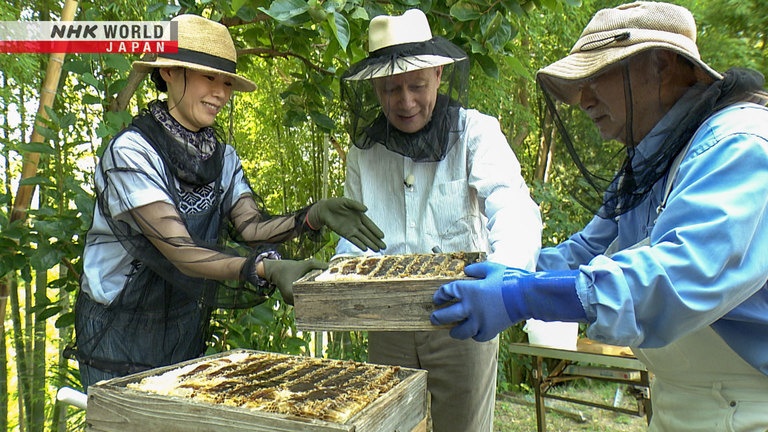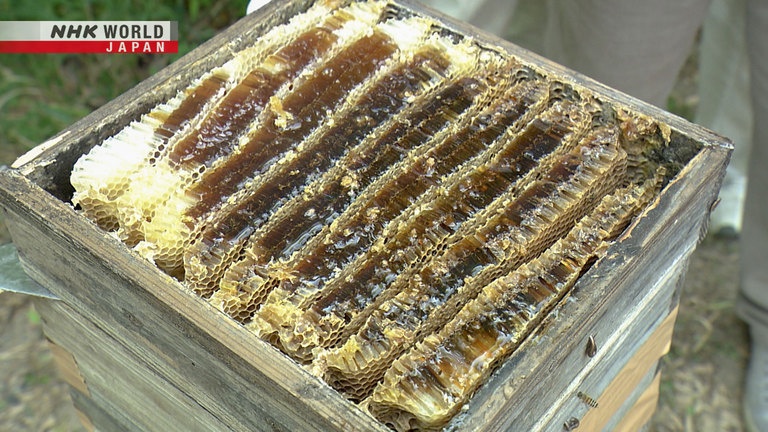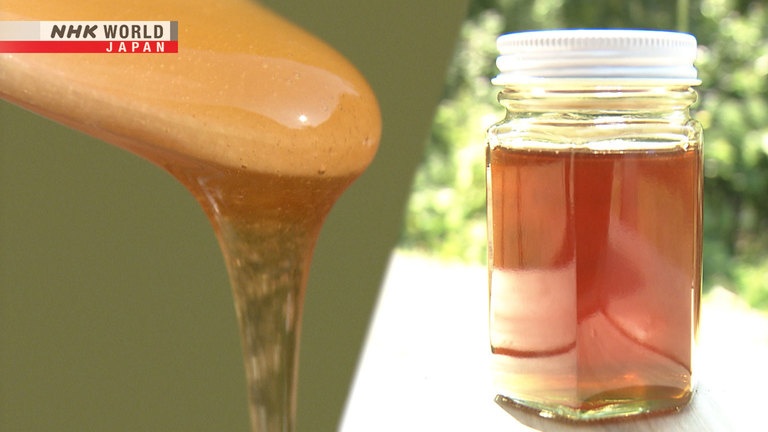Japanese Honeybees
*First broadcast on September 14, 2023.
Japanese honeybees are wild, difficult to farm, and produce less honey than the Western honeybees used for most commercial honey production. But the multifloral honey they produce has a rich and complex flavor. Caring for Japanese honeybees brings hobbyist beekeepers closer to the profundity and unpredictability of nature. We learn about creative approaches to looking after Japanese honeybees, and about the surprising way they deal with predators.



Transcript
Hello, and welcome to Japanology Plus.
I'm Peter Barakan.
I'm way up in a mountain
outside Nagoya in central Japan.
And our program today is about honeybees.
Now, what do honeybees have to do
with Japan, you may be asking yourself.
It turns out that almost 100%
of the honey that we find in shops
comes from Western honeybees,
which also exist here in Japan.
Their honey is mass produced;
that's why it's in the shops.
Japanese honeybees are wild.
They produce much less honey;
it's therefore that much more expensive,
which is why you don't find it
in the shops.
I don't think I've ever
had any Japanese honey.
I'm going to today,
and both you and I are going
to learn quite a lot
about Japanese bees and beekeeping.
Hello.
Hello.
Shinkai-san, nice to meet you.
Nice to meet you, too.
I'm looking forward to this.
So am I.
Our guest is Shinkai Rika,
an ecological anthropologist.
She's kept Japanese honeybees herself,
and is an expert on Japan's
beekeeping culture and history.
Have you ever seen honeybees?
You know, there are different kinds
of bees, aren't there?
There's honeybees and bumble bees
and all kinds of bees, I think.
I'm not quite sure
which ones honeybees are.
Yes, it can be quite hard to tell.
I'm sure you've eaten honey
in many countries.
It will all have come
from Western honeybees.
Apparently, yes.
But Japan has its own variety:
the Japanese honeybee.
The Japanese honeybee
is a subspecies of the Asian honeybee.
They make their nests in enclosed spaces,
such as hollows in tree trunks,
and live together in colonies.
Each colony contains thousands
of bees—sometimes up to 20,000.
A nest is arranged
into long parallel combs.
The largest bee is the queen.
There's only one in each colony.
The queen's job is to lay eggs.
Each egg looks like a tiny grain of rice.
Most of the other bees are workers—
and they're all female.
They look after the eggs,
and build the nest.
They also fetch nectar from flowers.
This is a crucial task.
At the nest, the nectar is transformed
into honey and stored for later.
Japanese honeybees can only make
a relatively small amount of honey.
For that reason, beekeepers can
only harvest it around once a year.
The bees collect nectar
from many different flowers blooming
in their local environment.
The nectar becomes the raw material
for making “multifloral honey.”
Most honey found in shops, meanwhile,
comes from Western honeybees.
Methods for mass-producing
that type of honey are well established.
We've come to meet a specialist
in Western honeybees.
How much honey do you get
from each hive, generally speaking?
In this area, around 24 kilos per hive.
Wow. That's a lot of honey.
How many times a year
will you collect the honey?
Generally around four or five times.
OK.
Through commercial beekeeping,
Western honeybees produce nearly
ten times more honey
than Japanese honeybees.
Wooden frames, set in boxes, give bees
the perfect place to make a nest.
The box itself may contain
as many as 30,000 bees.
Each frame can be taken out
of the box and inspected separately.
When they're full of honey,
it can be easily harvested.
So it's very efficient.
Also, frame-type hives are very sturdy,
and can be easily moved.
For example, as you may know,
certain honeys are associated
with specific flowers.
You can move the hives to the places
where those flowers are blooming.
That way the bees
can easily collect the nectar.
OK.
Western honeybees can be encouraged
to collect nectar
from a single type of flower.
The result is single-flower honey.
Western honeybees produce
a great deal of commercially
valuable honey in many varieties—
and they are relatively easy to handle.
But when it comes
to Japanese honeybees,
commercial beekeeping is difficult.
When there's a lack of nectar nearby,
the entire colony tends to leave the nest.
They're basically wild.
In general, they can't be settled
permanently in a single hive.
OK, I'm starting to get
a picture of how different
the Japanese honeybees are now.
Yes, and let's take a look
at this to learn more.
On this side are Western honeybee workers.
Over here are Japanese workers.
And at the top are the queens.
What do you think?
These are quite a bit smaller.
And the color's different
as well, isn't it?
These are the typical sort
of black and yellow stripes,
and these...they're stripes,
but it's harder to see the stripes
because they're kind of a darker color.
Yes, they have a darker color overall.
Japanese honeybees may be small,
but they have a surprising
and effective strategy against
one natural predator in particular.
The northern giant hornet.
The hornet wants
to take the honeybee larvae
as food for its own colony's larvae.
The bees must repel it.
For example, they can make
a coordinated threatening buzz.
And if the hornet
actually enters the nest...
Hundreds of workers will quickly
engulf it in a writhing ball of bees.
Less than an hour later,
the hornet is dead.
But why does this strategy work against
an enemy four times the size of a bee?
The bees vibrate,
raising their temperature.
Within the ball, it becomes
over 45 degrees Celsius,
which is enough to kill the hornet.
This is known as a “heat ball.”
Japanese honeybees stand
up to their attackers
via a tactical sequence of behavior
that is rarely seen in Western honeybees.
It's incredible how the survival instinct
in animals will make them
do things like that.
It's amazing, isn't it?
Here we see various Japanese hornets,
and this is a giant hornet worker.
It's a pretty amazing difference in size.
I mean, even for humans,
these are pretty scary creatures.
So for them...I mean,
the bravery involved...
I mean, I know there's a lot of them,
but the courage it takes to do that...
I mean, it just tells you
how threatened they feel by these.
I would run a mile rather than try
and confront one of these creatures.
Yes, it is very brave of them
to fight back.
Giant hornets don't exist
in the original habitats
of the Western honeybee.
But Japanese honeybees
had to find a way of fighting
back against this local enemy.
The earliest mention of the word “bee”
in Japan's written history
comes from the 7th century.
This says that a prince
from the Korean peninsula
attempted beekeeping in Japan.
In the 11th century, a leader
called Fujiwara no Michinaga fell ill.
Records show that to get better,
he took something called “so,”
a form of boiled-down milk.
It seems that this “so”
was mixed with honey.
From the 19th century,
there are many records
describing beekeeping in Japan.
Wakayama and Hiroshima
were particularly well-known
for their honey production.
Then, in 1877, came a monumental change.
As part of Japan's modernization,
Western honeybees were brought
to Japan from the USA,
and beekeeping became industrialized.
So in the late 19th century,
in order to modernize the country,
Japan starts importing all sorts of
things, including honeybees from America.
How much effect does
that have on Japanese honeybees?
Well, when Western honeybees arrived
from the United States,
beekeepers had to learn
what to do through trial and error.
Eventually people started buying
and selling queen bees to start colonies,
and modern beekeeping got started
across the country.
They had hives that contained frames.
And a centrifuge was used
to extract the honey.
That's an efficient way
to extract large volumes.
For the Japanese honeybee,
they tried to make similar hives
and modernize in the same way.
But it didn't go well,
and so commercial beekeeping spread
with the focus on Western honeybees.
Japanese honeybees are difficult
to work with on a business basis.
But keeping them is nevertheless
an increasingly popular hobby.
Mochizuki-san, nice to meet you.
I'll keep my hat on
because it's really hot today.
You're right. It's boiling hot.
So you're a hobbyist beekeeper?
Yes, and you'll meet my friends.
But first, shall we
take a look at the bees?
OK, great. Yes.
Just this way.
So this is the hive.
We keep it simple.
This stacked-box type
makes it easy to harvest honey.
I see you've got kind of a canopy
over the top and on the side as well.
Is that to protect the bees
from the heat, or the sun, or what?
That's right.
It's hot, so we made a canopy
to block the sun on the western side.
The beekeepers encourage
colonies to gather
by appealing to the
natural behavior of bees.
When spring comes,
a new queen is born—at the end
of a multi-step process.
Shortly before that,
the existing queen leaves the nest,
accompanied by half of the colony.
They will gather on a nearby tree,
and search for a new home.
When a destination is decided...
The swarm moves as one.
This is how bee colonies
increase in number.
Mochizuki's group places
a wooden swarm-catcher in the trees,
to encourage the bees to gather.
When the bees have settled,
they are transferred to a hive.
Inside is a single open space.
The bees make combs
that hang down from the top.
This is different from the frames
used commercially for Western honeybees.
Peter's going to try his hand
at harvesting honey.
First, the top of the box is removed
with the honeycomb attached.
Slightly remove.
Slightly. Just a little bit.
You can see honey.
Oh right, yes. Whoa.
Bees store honey at the top of the hive,
so that's why the top is removed.
Now what's he doing there?
Using a blower so
that the bees keep their distance.
We have to take things slowly.
Japanese honeybees are sensitive,
so it's important to be careful
not to disturb them.
Now let's examine the bottom of the hive.
This is where the bees store pollen,
and raise their young.
As the honeycomb hangs down,
the hive may need to be made taller
by adding extra boxes at the bottom.
The tools are all handmade
by the members of the group.
I actually came up with this myself.
Ah, really?
Ah. And there's no vibration, of course.
Toolmaking is one of the pleasures
of this hobby.
Stacked-box hives are traditional,
but they've been especially
popular since the start of this century.
Removing the top and cutting
off pieces of honeycomb is very easy.
So it's common among hobbyist beekeepers.
Various other types of hive
are made and used in Japan.
First, a type on the island
of Tsushima, in Nagasaki.
It's made using a hollowed-out tree trunk,
and so it resembles a natural
environment for a bees' nest.
By simply removing the lid,
honey can easily be harvested.
Here's a type with a similar shape,
from Nagano.
Unusually, it's placed on its side.
Here's a model from Wakayama
with a front panel.
Removing this gives you
a full view of the nest.
It's time for a tasting session.
These two layers are from the hive.
You can try the best bits.
Oh, wow.
It's a rare chance
to try Japanese comb honey.
Yeah, that'll be a new experience.
Wow.
Rich, isn't it?
It's a really strong taste.
I'm a little surprised.
And I don't know...
it doesn't taste like regular honey;
there's something kind
of more complex about it.
Wild honey.
Let's learn more about
keeping Japanese honeybees.
After building a hive,
where do you get the bees from?
In spring, when a swarm leaves the nest,
the bees are encouraged to start
a new colony in an empty beehive.
A swarm will leave a nest on a warm,
humid day with no wind.
So we know when to capture the bees.
Japanese honeybees tend
to gather together on thick tree branches.
So that's the best place to catch them.
If you treat them well,
they'll behave well.
They react to the way that you treat them?
They do.
They're very clever.
Bees are so smart.
Capturing a swarm is a moment of triumph.
Sumita says he'll always
remember his first time.
I made a hive, and put it in place.
Then the sky went black.
Bees flew down, and went straight in.
May the 19th, 2011. I'll never forget it.
You must have been thrilled.
I certainly was.
And I've kept bees ever since.
You were saying you know
all this from experience.
How long have you all been
involved in this?
Around 14 years?
10 to 14 years.
But we don't make any money.
I was going to say.
I mean, if you don't make any money,
as it's only a fairly small amount
of honey that you can get in a year,
what keeps you doing it for so long?
It's just so interesting
watching the bees at work.
Their behavior seems so human.
They defend their home.
If ants come in, they expel them.
A swallow flying by might try
to catch bees,
but the colony will angrily chase it away.
You can see how hard they work
to protect the colony. I enjoy that.
Is it like having a pet?
Oh, I love them more than a pet.
If they suddenly leave, it's terrible.
It really is.
When there are roadworks,
the drilling causes vibrations.
If that's not far from a nest,
the bees will leave.
They rise up in huge numbers,
and fly away.
So we like to be told
about upcoming roadworks.
If there aren't enough flowers nearby,
or if there's a lot of noise,
they will go in search
of a better environment.
They move.
The whole colony leaves at once.
If life becomes difficult,
they disappear in the blink of an eye.
That's happened again and again.
So everyone has to work out how to
encourage the bees to stay in the hives.
And that's a fun part of the hobby.
It's so disappointing when they leave.
But it inspires you to learn more
about their behavior.
That's exactly right.
It's fascinating.
There's so much for us
to learn from the bees.
At this high school, in Aichi,
students learn about beekeeping
by using hives on the school grounds.
Today, we'll start here.
Lift this up. Here.
We're lifting this part? Here?
Yes.
- This bit.
- Right, OK.
The students take care of everything.
They build and maintain the hives,
and then harvest the honey.
The project was started
by Mizuno Takahiko,
an expert in the science of flowers.
He sees beekeeping as a great way
to make students more aware
of local ecosystems.
Our school grounds include this patch
of natural woodland.
But students don't have many
opportunities to interact with it.
Working with insects
offers them that chance,
and teaches them
about the value of nature.
By looking after Japanese honeybees,
students learn how fascinating—
and unforgiving—the natural world can be.
A giant hornet arrived,
and the bees attacked it.
But the hornet called its friends.
They kept coming, again and again.
That's how nature works.
But I was sad for the bees.
Mizuno teaches the children
about the ecosystem
by explaining the role
that honeybees play.
Flowers produce... nectar.
And thanks to that...
pollen can be carried away by bees.
So bees play a really crucial role.
Thanks to these lessons,
students are more conscious
of different aspects of nature.
At first, it was all new.
But then white clover
brought it to life for me.
Because that was a flower
I already knew about.
That made it interesting.
We learned that flowers
are a source of nectar.
We can grow flowers at home.
Or in our neighborhoods,
and around the city.
Then we can expand the environment
that's suitable for Japanese honeybees.
So even small steps
can make a big difference.
Working with wild Japanese honeybees
has deepened the students' understanding
of the natural environment.
Earlier, we tasted comb honey made
by Japanese honeybees.
Now let's try honey in a jar.
Two types of honey.
Tasting time again.
On the right, honey from Kyoto.
On the left, honey from Nagano.
OK, you can see the colors
are different, for a start.
Yes, you're right. Different.
If you actually want to go out
and buy some of these,
is it easy to find them these days?
Well, honey from Japanese honeybees
is sold at local shops.
Or you see it online.
I'll have a little try.
Go ahead.
OK.
Mmm.
Nice aroma to it.
It's very floral tasting.
Yes, it really is. ...
Now this one.
Oh, that's very different.
It's a little tart.
Just a little bit sour.
Yes.
There's a sort of plum flavor
to that, very slightly.
I don't know if it is plums,
but it has that kind of a feel to it.
Very tasty though, yeah.
Right.
Both types were one year's produce
made from nectar gathered
within a 2-kilometer radius.
And so each honey
has a clearly different taste.
Japanese honeybees collect nectar
from a local ecosystem.
And so the flowers in
that particular environment
are represented in the flavor
of the honey that the bees produce.
It's like different types of wine.
Tasting them is really fun.
OK, I shall keep my eyes peeled next time
I'm off somewhere.
Yes—think of yourself as a honey hunter!
Thank you very much.
My pleasure. Thank you.